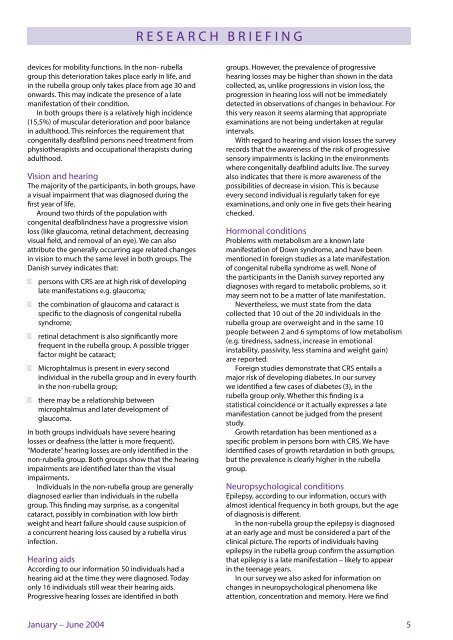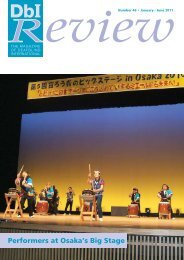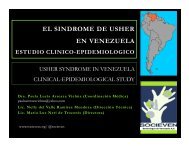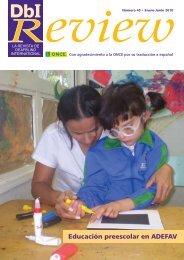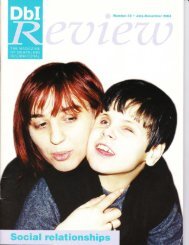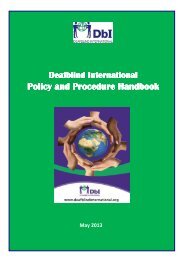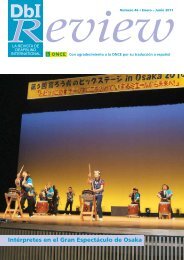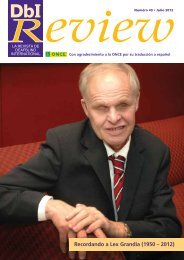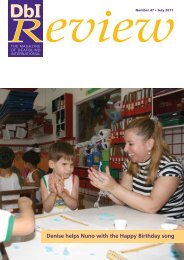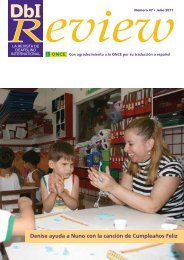Families in Nepal - Deafblind International
Families in Nepal - Deafblind International
Families in Nepal - Deafblind International
Create successful ePaper yourself
Turn your PDF publications into a flip-book with our unique Google optimized e-Paper software.
esearch brief<strong>in</strong>gdevices for mobility functions. In the non- rubellagroup this deterioration takes place early <strong>in</strong> life, and<strong>in</strong> the rubella group only takes place from age 30 andonwards. This may <strong>in</strong>dicate the presence of a latemanifestation of their condition.In both groups there is a relatively high <strong>in</strong>cidence(15,5%) of muscular deterioration and poor balance<strong>in</strong> adulthood. This re<strong>in</strong>forces the requirement thatcongenitally deafbl<strong>in</strong>d persons need treatment fromphysiotherapists and occupational therapists dur<strong>in</strong>gadulthood.Vision and hear<strong>in</strong>gThe majority of the participants, <strong>in</strong> both groups, havea visual impairment that was diagnosed dur<strong>in</strong>g thefirst year of life.Around two thirds of the population withcongenital deafbl<strong>in</strong>dness have a progressive visionloss (like glaucoma, ret<strong>in</strong>al detachment, decreas<strong>in</strong>gvisual field, and removal of an eye). We can alsoattribute the generally occurr<strong>in</strong>g age related changes<strong>in</strong> vision to much the same level <strong>in</strong> both groups. TheDanish survey <strong>in</strong>dicates that: persons with CRS are at high risk of develop<strong>in</strong>glate manifestations e.g. glaucoma;the comb<strong>in</strong>ation of glaucoma and cataract isspecific to the diagnosis of congenital rubellasyndrome;ret<strong>in</strong>al detachment is also significantly morefrequent <strong>in</strong> the rubella group. A possible triggerfactor might be cataract;Microphtalmus is present <strong>in</strong> every second<strong>in</strong>dividual <strong>in</strong> the rubella group and <strong>in</strong> every fourth<strong>in</strong> the non-rubella group;there may be a relationship betweenmicrophtalmus and later development ofglaucoma.In both groups <strong>in</strong>dividuals have severe hear<strong>in</strong>glosses or deafness (the latter is more frequent).“Moderate” hear<strong>in</strong>g losses are only identified <strong>in</strong> thenon-rubella group. Both groups show that the hear<strong>in</strong>gimpairments are identified later than the visualimpairments.Individuals <strong>in</strong> the non-rubella group are generallydiagnosed earlier than <strong>in</strong>dividuals <strong>in</strong> the rubellagroup. This f<strong>in</strong>d<strong>in</strong>g may surprise, as a congenitalcataract, possibly <strong>in</strong> comb<strong>in</strong>ation with low birthweight and heart failure should cause suspicion ofa concurrent hear<strong>in</strong>g loss caused by a rubella virus<strong>in</strong>fection.Hear<strong>in</strong>g aidsAccord<strong>in</strong>g to our <strong>in</strong>formation 50 <strong>in</strong>dividuals had ahear<strong>in</strong>g aid at the time they were diagnosed. Todayonly 16 <strong>in</strong>dividuals still wear their hear<strong>in</strong>g aids.Progressive hear<strong>in</strong>g losses are identified <strong>in</strong> bothgroups. However, the prevalence of progressivehear<strong>in</strong>g losses may be higher than shown <strong>in</strong> the datacollected, as, unlike progressions <strong>in</strong> vision loss, theprogression <strong>in</strong> hear<strong>in</strong>g loss will not be immediatelydetected <strong>in</strong> observations of changes <strong>in</strong> behaviour. Forthis very reason it seems alarm<strong>in</strong>g that appropriateexam<strong>in</strong>ations are not be<strong>in</strong>g undertaken at regular<strong>in</strong>tervals.With regard to hear<strong>in</strong>g and vision losses the surveyrecords that the awareness of the risk of progressivesensory impairments is lack<strong>in</strong>g <strong>in</strong> the environmentswhere congenitally deafbl<strong>in</strong>d adults live. The surveyalso <strong>in</strong>dicates that there is more awareness of thepossibilities of decrease <strong>in</strong> vision. This is becauseevery second <strong>in</strong>dividual is regularly taken for eyeexam<strong>in</strong>ations, and only one <strong>in</strong> five gets their hear<strong>in</strong>gchecked.Hormonal conditionsProblems with metabolism are a known latemanifestation of Down syndrome, and have beenmentioned <strong>in</strong> foreign studies as a late manifestationof congenital rubella syndrome as well. None ofthe participants <strong>in</strong> the Danish survey reported anydiagnoses with regard to metabolic problems, so itmay seem not to be a matter of late manifestation.Nevertheless, we must state from the datacollected that 10 out of the 20 <strong>in</strong>dividuals <strong>in</strong> therubella group are overweight and <strong>in</strong> the same 10people between 2 and 6 symptoms of low metabolism(e.g. tiredness, sadness, <strong>in</strong>crease <strong>in</strong> emotional<strong>in</strong>stability, passivity, less stam<strong>in</strong>a and weight ga<strong>in</strong>)are reported.Foreign studies demonstrate that CRS entails amajor risk of develop<strong>in</strong>g diabetes. In our surveywe identified a few cases of diabetes (3), <strong>in</strong> therubella group only. Whether this f<strong>in</strong>d<strong>in</strong>g is astatistical co<strong>in</strong>cidence or it actually expresses a latemanifestation cannot be judged from the presentstudy.Growth retardation has been mentioned as aspecific problem <strong>in</strong> persons born with CRS. We haveidentified cases of growth retardation <strong>in</strong> both groups,but the prevalence is clearly higher <strong>in</strong> the rubellagroup.Neuropsychological conditionsEpilepsy, accord<strong>in</strong>g to our <strong>in</strong>formation, occurs withalmost identical frequency <strong>in</strong> both groups, but the ageof diagnosis is different.In the non-rubella group the epilepsy is diagnosedat an early age and must be considered a part of thecl<strong>in</strong>ical picture. The reports of <strong>in</strong>dividuals hav<strong>in</strong>gepilepsy <strong>in</strong> the rubella group confirm the assumptionthat epilepsy is a late manifestation – likely to appear<strong>in</strong> the teenage years.In our survey we also asked for <strong>in</strong>formation onchanges <strong>in</strong> neuropsychological phenomena likeattention, concentration and memory. Here we f<strong>in</strong>dJanuary – June 2004 5


